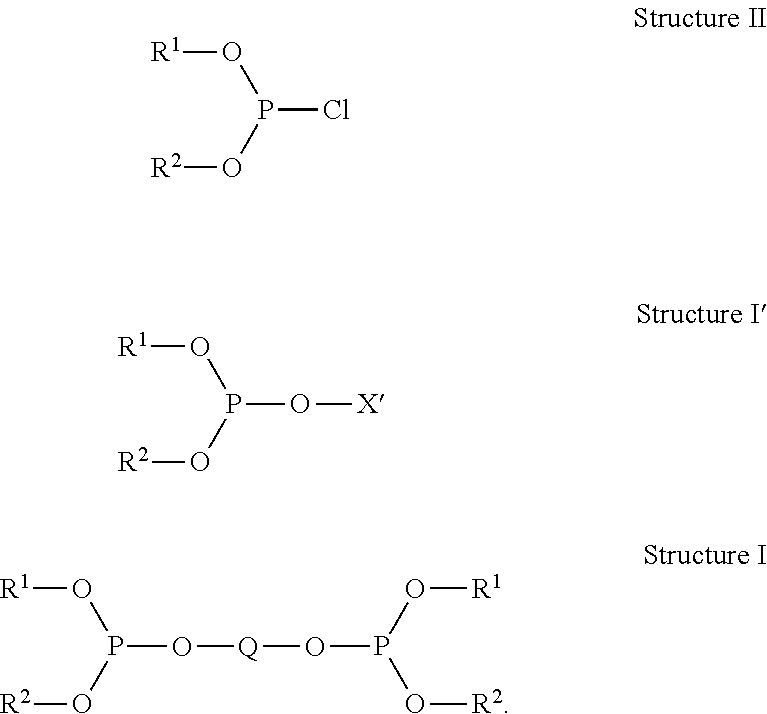Method for making organodiphosphites from phosphorochloridites characterized by measuring side-product levels to determine further additions
a phosphorochloridite and organodiphosphide technology, applied in the direction of group 5/15 element organic compounds, chemical instruments and processes, organic chemistry, etc., can solve the problems of relatively high nickel consumption, relative low catalyst activity, and add significantly to operating cost and process complexity, and achieve high yield, high yield, and high controllable effect of impurities and hydrolysis
- Summary
- Abstract
- Description
- Claims
- Application Information
AI Technical Summary
Benefits of technology
Problems solved by technology
Method used
Image
Examples
example 1
Phosphorus Distribution—Starting Mixture
[0203]
Phosphorus Containing ComponentMol % P (approx)Kg (approx)DLS00TLS85.7CLS00Phosphorochloridite8748.7LHP2Other3
[0204]First serial dose—To the stirred suspension was added a stoichiometric excess of triethylamine (20.3 kg) in one portion followed by bisaryl compound (22.3 kg) dissolved in toluene (36 wt %) dosed continuously over about 2 hours. The reaction mixture was then analysed by 31P NMR.
[0205]Phosphorus Distribution—First Reaction Mixture
[0206]
Phosphorus Containing ComponentMol % P (approx)Kg (approx)DLS6954.7TLS1410.1CLS21.7Phosphorochloridite105.6LHP3Other2
[0207]Second Serial dose—The second serial dose was calculated by running a by-product accumulation model. Using the selectivity ratio for the respective ranges of phosphorochloridite conversion, it was forecasted that molar percent of phosphorus present as CLS in the final reaction mixture would exceed 3% if the bisaryl addition continued to complete conversion of the phosphoro...
example 2
Phosphorus Distribution—Starting Mixture
[0215]
Phosphorus Containing ComponentMol % P (approx)Kg (approx)DLS00TLS96.5CLS00Phosphorochloridite8648.1LHP1Other4
[0216]First Serial Dose—To the stirred suspension was added a stoichiometric excess of triethylamine (22 kg) in one portion and bisaryl compound (22.8 kg) dissolved in toluene (30.5 wt %) dosed continuously over about 2 hours. The reaction mixture was then analysed by 31P NMR.
[0217]Phosphorus Distribution—First Reaction Mixture
[0218]
Phosphorus Containing ComponentMol % P (approx) Kg (approx)DLS6853.9TLS1510.5CLS2.42.1Phosphorochloridite10.35.6LHP2.3Other2
[0219]Second Serial Dose—It was forecasted that the percentage of phosphorus present as CLS in the second reaction mixture would reach 3% at about 95% phosphorochloridite conversion.
[0220]Selectivity Ratios at Various Conversion Ranges
[0221]
Molar SelectivityRatioPhosphorochloridite ConversionDLSCLSTLS90% to 98%61198% to 100%111
[0222]By-Product Accumulation Model
[0223]
Phosphorochl...
example 3
Phosphorus Distribution—Starting Mixture
[0227]
Phosphorus Containing ComponentMol % P (approx)Kg (approx)DLS00TLS11.48.3CLS00Phosphorochloridite8145.6LHP3.6Other4
[0228]First Serial Dose—To the stirred suspension was added a stoichiometric excess of triethylamine (21 kg) in one portion and bisaryl compound (22.3 kg) dissolved in toluene (35.4 wt %) dosed continuously over about 2 hours. The first reaction mixture was then analysed by 31P NMR.
[0229]Phosphorus Distribution—First Reaction Mixture
[0230]
Phosphorus Containing ComponentMol % P (approx)Kg (approx)DLS66.652.8TLS13.39.5CLS21.7Phosphorochloridite11.86.6LHP2.6Other3.7
[0231]Second Serial Dose—It was forecasted that the molar percentage of phosphorus present as CLS in the second reaction mixture would reach about 3% at about 96% phosphorochloridite conversion.
[0232]Selectivity Ratios at Various Conversion Ranges
[0233]
Molar Selectivity RatioPhosphorochloridite ConversionDLSCLSTLS90% to 98%61198% to 100%111
[0234]By-Product Accumulati...
PUM
| Property | Measurement | Unit |
|---|---|---|
| mole percent | aaaaa | aaaaa |
| temperature | aaaaa | aaaaa |
| temperature | aaaaa | aaaaa |
Abstract
Description
Claims
Application Information
 Login to view more
Login to view more - R&D Engineer
- R&D Manager
- IP Professional
- Industry Leading Data Capabilities
- Powerful AI technology
- Patent DNA Extraction
Browse by: Latest US Patents, China's latest patents, Technical Efficacy Thesaurus, Application Domain, Technology Topic.
© 2024 PatSnap. All rights reserved.Legal|Privacy policy|Modern Slavery Act Transparency Statement|Sitemap



